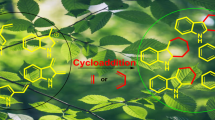Abstract
A simple and green methodology has been developed for the syntheses of some new 2-styrylbenzimidazoles. In this method, 2-styrylbenzimidazoles 6(a–x) were synthesized by the condensation of o-phenylenediamines 4(a–c) with cinnamic acids 3(a–h) using glycerol containing boric acid (10 mol%) as the reaction medium at 180 °C about 3–5 h. The cinnamic acids 3(a–h) were obtained by the condensation between aromatic aldehydes 1(a–h), and malonic acid using a new heterogeneous catalytic system such as alum-Cs2CO3 in water is described. Compounds 6(a–x) were also obtained alternatively by the condensation of 2-methylbenzimidazoles 5(a-c) with 1(a-h) using the same glycerol containing boric acid (10 mol%) as reaction medium at 180 °C for 5–6 h. The catalytic systems mentioned here were found to be highly active, stable, and recyclable under reaction conditions. All the newly synthesized compounds were characterized by IR, Mass, and NMR spectral analyses. All synthesized compounds were screened for their antimicrobial activity against the clinical strains which include gram-positive bacteria (Micrococcus luteus MTCC 2470, Staphylococcus aureus MTCC 96, Staphylococcus aureus MLS-16 MTCC 2940, Bacillus subtilis MTCC 121) and gram-negative bacteria (Escherichia coli MTCC 739, Pseudomonas aeruginosa MTCC 2453, Klebsiella planticola MTCC 530, and Candida albicans MTCC 3017). The results revealed that compounds (6b, 6g, 6h, 6j, 6k, 6n, 6o, 6t) exhibited significant antibacterial activity almost equal to the standard drug, i.e., Ciprofloxacin.








Similar content being viewed by others
References
Amsterdam D, Loman V (eds) (1996) Antibiotics in laboratory medicine, 4th edn. Williams & Wilkins, Baltimore, pp 52–111
Azizian J, Mohammoladi AA, Karimi AR, Mohammoladizadeh MR (2006) KAl(SO4)2·12H2O (alum) a reusable catalyst for the synthesis of some 4-substituted coumarins via Pechmann reaction under solvent-free conditions. Appl Catal A 300:85
Bahrami K, Khodaei MMOL, Kavianinia I (2007) A simple and efficient one-pot synthesis of 2-substituted benzimidazoles. Synthesis 4:547–550
Berg DV, Zoellner KR, Ogunrombi MO, Malan SF, Blanche GT, Castagnoli N, Bergh JJ, Petzer JP (2007) Inhibition of monoamine oxidase B by selected benzimidazole and caffine analogues. Bioorg Med Chem 15:3692–3702
Cernatescu C, Comanita E (2005) Benzazole derivatives IV. Chem Ind Chem Eng Q 11(1):19–24
Corper HJ, Gauss H, Gekler WA (1920) Studies on the inhibitory action of sodium cinnamate in tuberculosis. Colo Am Rev Tuberc 4:464–473
Dabiri M, Baghbanzadeh M, Kiani S, Vakilzadeh Y (2007) Alum (KAl(SO4)2·12H2O): An Efficient and inexpensive catalyst for the one-pot synthesis of 1,3,4-oxadiazoles under solvent-free conditions. Monatsh Chem 138:997
Dubey PK, Kumar R, Grossert JS, Hooper DL (1999) A facile and convenient method for the synthesis of 2-styrylbenzimidazoles. Indian J Chem 38B:1211–1213
Evans BE, Rittle KE, DiPardo RM, Freidinger RM, Whitter WL, Lundell GF, Veber DF, Anderson PS (1988) Methods for drug discovery: development of proteins, selective, orally effective cholecystokinin antagonists. J Med Chem 31(12):2235–2246
Gainsborough H (1928) A note on the use of benzyl cinnamic ester in tuberculosis. The method of Jacobsen. Lancet 211(5462):908–909
Gu Y, Jerome F (2010) Glycerol as sustainable solvent for green chemistry. Green Chem 12:1127–1138
Gu Y, Barrault J, Jerome F (2008) Glycerol as an efficient promoting medium for organic reactions. Adv Synth Catal 350:2007–2012
Heravi MMOL, Sadjadi S, Oskooie HA, Shoar RH, Bamoharram FF (2008) Heteropolyacids as heterogeneous and recyclable catalysts for the synthesis of benzimidazoles. Catal Commun 9:504–507
Jacobson MJ (1919) Ethylcinnamate in experimental tuberculosis. Bull Mém Soc Méd Hôsp Paris 35:322–325
Jacobus P, Petzer Salome S, Castagnoli KP, Chen Jiang-Fan, Schwarzschild MA, Van der Schyf CJ, Castagnoli N (2003) Inhibition of monoamine oxidase b by selective adenosine A2A receptor antagonists. Bioorg Med Chem 11:1299–1310
Khalafi-Nezhad A, Rad MNS, Mohbatkar H, Asrari Z, Hemmolateenejad B (2005) Design, synthesis, antibacterial and QSAR studies of benzimidazole and imidazole chloroaryloxyalkyl derivatives. Bioorg Med Chem 13(6):1931–1938
Li CJ (1993) Organic reactions in aqueous media with a focus on carbon-carbon bond formation. Chem Rev 93:2023
Marcus AV, Alencar de, Edgar FO de Jesus, Alexandre RM, Jose, Silva SL (2005) International Nuclear Atlantic Conference-INAC, Santos, Brazil, August 28 to September 2
Nakamoto K (1991) Infrared Spectra and Raman Spectra of Inorganic and Coordination Compounds. [Russian translation], Moscow, pp. 153, 518–519
Narasimhan B, Sharma D, Kumar P (2012) Benzimidazole: a medicinally important heterocyclic moiety. Med Chem Res 21(3):269–283
Pellerin C (2005) Chemistry goes green. ejournal USA; Global Issues: June
Pyysalo T, Torkkeli H, Honkanen E (1977) The thermal decarboxylation of some substituted cinnamicacids. Lebensm Wiss Technol 10:145
Santosh SC, Chandrashekhar DU (2011) Synthesis and antioxidant activity of some novel 2-substituted analogues of benzimidazoles. J Pharm Res 4(2):340–343
Shingalapur RV, Hosamani KM, Keri RS (2009) Synthesis and evaluation of in vitroanti-microbial and anti-tubercular activity of 2-styrylbenzimidazoles. Eur J Med Chem 44(10):4244–4248
Sullivan WR (1970) New benzimidazoles. J Med Chem 13(4):784–786
Suresh KD, Sandhu JS (2011) Alum [KAl(SO4)2·12H2O] an efficient, novel, clean catalyst for Doebner Knovenagel Reaction for efficient production of α, β-unsaturated acids. Ind J Chem 50B:1479–1483
Tempest P, Ma V, Thomas S, Hua Z, Kelly CH (2001) Two-step solution-phase synthesis of novel benzimidazoles utilizing a UDC (Ugi/de-Boc/cyclize) strategy. Tett Lett 42:4959–4962
Warbasse JP (1894) Cinnamic acid in the treatment of tuberculosis. Ann Surg 19:02–117
Wojciechowska R, Wojciechowski W, Kamiński J (1988) Thermal decomposition of ammolonium and potash alums. J Therm Anal 33:503–509
Wolfson A, Dlugy C, Shotland Y (2007) Glycerol as a green solvent for high product yields & selectivity. Environ Chem Lett 5:67–71
Xiangming H, Huiqiang M, Yulu M (2007) p-TsOH Catalyzed synthesis of 2-arylsubstituted benzimidazoles. Arkivoc xiii:150–154
Acknowledgments
The Authors are thankful to Jawaharlal Nehru Technological University Hyderabad College of Engineering, Hyderabad for providing laboratory facilities and also grateful for CSIR-CDRI, Lucknow for providing financial support in the form of OSDD Project. The authors are also thankful to CFRD, Osmania University, Hyderabad for providing Spectral analysis facilities.
Author information
Authors and Affiliations
Corresponding author
Rights and permissions
About this article
Cite this article
Ashok Kumar, T., Kishore Babu, P.N. & Rama Devi, B. Syntheses of arylcinnamic acids, using Alum-Cs2CO3 as precursors of new 2-heterostyrylbenzimidazoles and their antimicrobial evaluation. Med Chem Res 24, 1351–1364 (2015). https://doi.org/10.1007/s00044-014-1208-5
Received:
Accepted:
Published:
Issue Date:
DOI: https://doi.org/10.1007/s00044-014-1208-5




